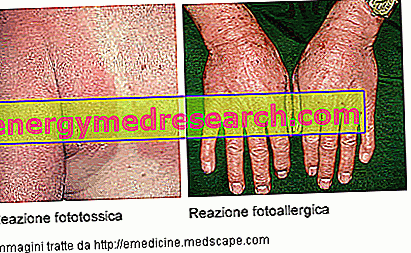Definition
Photosensitivity is an abnormal and exaggerated reaction of the skin, which becomes particularly sensitive to damage caused by sun exposure; a photodermatosis is thus manifested - or a rash rash characterized by erythemas (redness), itching and burns - even after slight exposure to sunlight.
Individual sensitivity to ultraviolet radiation depends on several factors: genetic predisposition, metabolic disorders and abnormalities in pigmentation or DNA repair mechanisms.
Photodermatoses can be classified into four groups based on their etiology:
- Idiopathic photodermatoses : light polymorphic eruption, chronic actinic dermatitis, solar urticaria and actinic prurigo;
- Genetic photodermatoses : cutaneous porphyrias, Bloom's syndrome and systemic lupus erythematosus;
- Metabolic photodermatoses : porphyrias and pellagra;
- Exogenous photodermatoses : drug-induced photosensitivity and phytophotodermatosis.

Generally, photodermatosis can be the result of two different mechanisms of action:
- phototoxicity reaction : phototoxic reactions (most common) tend to occur a few hours after sun exposure; the inflammatory reaction that characterizes them is independent of the intervention of the immune system
- photoallergy : photoallergic reactions occur within 24-72 hours and are mediated by the immune system
Often, patients do not associate the eruption of the skin to a recent sun exposure, in fact some very sensitive people can also react to the winter sun, to the filtered and artificial light with wavelengths included in the range 280-400 nm.
Differences between phototoxic and photoallergic reaction
- Phototoxic reactions . In phototoxic reactions, solar radiation reacts with the drug or other substances deriving from its metabolism, altering its structure. These chemicals are irritating and toxic to cell membranes or DNA, and directly produce an inflammatory response on the skin (non-immune reaction) amplified by the solar reaction. The result is acute (with rapid onset) and is made evident by the appearance of red or hyperpigmented spots and, sometimes, small bubbles. The clinical aspect is similar to an exaggerated sunburn. Ultraviolet radiation (UVA) is more commonly associated with phototoxicity, but also UVB rays and visible light can contribute to this reaction. The phototoxic reaction rash is mainly confined to the area of the skin exposed to the sun. Generally a phototoxic reaction resolves spontaneously once the drug intake is stopped.
- Photoallergic reactions . In photoallergic reactions, exposure to ultraviolet radiation works by modifying the structure of the drug, which is recognized by the immune system as an invader (antigen). An allergic reaction is then induced (cell-mediated immunological response), which is manifested by inflammation of the skin in areas exposed to light (dermatitis). These skin diseases are characterized by hives, with redness, desquamation, and sometimes blisters and spots. Photoallergy occurs 24 to 72 hours after sun exposure and generally presents a chronic (long-lasting) course. Many chemicals capable of causing photoallergic reactions require their topical application, such as aftershave lotions, sun creams and sulfa drugs. This type of photosensitivity can recur after exposure to the sun, even after finishing the drug therapy; in addition, it can sometimes spread to areas of the skin surface that have not been directly exposed to the sun.
| Feature | Phototoxic reaction | Photoallergic reaction |
| Incidence | high | Low (uncommon) |
| Amount of agent needed to trigger photosensitivity | high | Small |
| Onset of reaction after exposure to agent and light | From minutes to hours | 24-72 hours |
| Need for multiple exposures (more than one) to the agent | No | Yes |
| Distribution | Only skin areas exposed to the sun | Areas exposed to the sun, but can also extend into unexposed areas |
| Clinical Features | Exaggerated sunburn | Dermatitis |
| Immune-mediated reaction | No | Yes, type IV |
What is ultraviolet light?
Ultraviolet (UV) light is the radiation energy emitted by the sun in the form of invisible light waves. Only UVA and UVB radiation can reach the earth's soil. Patients may be sensitive to a type of sunlight (ie only to UVB rays, UVA or visible light) or to a wider range of radiation. The most common photosensitivity is that which occurs due to UVA rays. Tanning lamps also produce UVA and / or UVB. These artificial rays influence the skin like the corresponding natural solar radiation.
Symptoms
The skin's abnormal response to sun exposure may include the development of a skin rash, the aggravation of an existing eruption, an exaggerated sunburn or symptoms such as itching, paresthesia (tingling) or burning. Disorders usually occur in areas exposed to the sun, including the face, neck, hands, forearms and the area under the chin.
Symptoms of the phototoxic reaction
Individuals with phototoxic reactions may initially experience a burning and tingling sensation. Generally, within the next 24 hours the redness appears in the areas exposed to the sun, such as the forehead, nose, hands, arms and lips, even if - in the most serious cases - even areas of the skin protected from the sun may be involved. The extent of skin damage can range from a slight redness to the formation of blisters (or blisters). The eruption that characterizes the phototoxic reaction resolves with the desquamation of the affected area within a few days. See photo Phototoxic contact dermatitis
Symptoms of photoallergic reactions
Individuals with photoallergic reactions may initially experience itching. This manifestation is followed by redness, swelling and eruptions in the area affected by sun exposure. When the drug is taken for the first time, symptoms may not appear for several days. The subsequent interactions between drug and sun can, instead, cause a more rapid response (1-2 days), as commonly happens in other allergic reactions. See photo Photallergic contact dermatitis.
Hyperpigmentation after reactions . The alteration of the pigmentation in the affected skin area can develop after the resolution of an episode of phototoxicity, but it is a rarer occurrence in a photoallergic reaction. In phototoxic reactions, high doses of medication and prolonged exposure to light may be required before this consequence can occur.
Therapies associated with photosensitivity
Many substances, ingested or applied to the skin, are known to cause photosensitivity reactions in susceptible individuals; this means that not all subjects taking these substances develop photosensitivity reactions.
The following table provides a brief overview of the most common drugs that can determine photosensitivity:
| Oral phototoxic drugs | Examples |
| Antibiotics |
|
| Antihistamines | Diphenhydramine |
| Antifungals | griseofulvin |
| antimalarial | Quinine, chloroquine and hydroxychloroquine |
| Chemotherapy | 5-fluorouracil, vinblastine and dacarbazine |
| antiarrhythmics | Amiodarone |
| Cardiovascular |
|
| lipid-lowering agents | Simvastatin |
| Diuretics | Furosemide, chlorothiazide, hydrochlorothiazide and bumetadine |
| Hypoglycemic | Sulfonylureas: chlorpropamide and glyburide |
| Anti-inflammatory | Thiaprophenic acid, carprofene, diclofenac, ketoprofen and naproxen |
| Farmaciper for acne | Isotretinoin and acitretin. |
| Antidepressants | Amitriptyline, desipramine, fluoxetine, fluvoxamine and imipramine |
| anxiolytics | Chlordiazepoxide |
| Neuroleptic | Alimemazine, chlorpromazine, levomepromazine, perphenazine, prochlorperazine, promethazine and thioridazine |
| Phototoxic drugs for local use | Examples |
| Antiacneici | Benzoyl peroxide, tretinoin and tazarotene |
| Antibacterials | Sulfanilamide |
| Antihistamine | Promethazine |
| Other phototoxic drugs | Medicinal Plants: St. John's Wort (or St. John's Wort) Oral contraceptives benzocaine 5-aminolevulinic acid Derivatives? ‹Of vitamin A: Etretinate |
| Photoallergic substances | Examples |
| Sunscreens |
|
| Antimicrobials | Chlorhexidine, hexachlorophene and dapsone |
| Painkillers | Celecoxib |
| Chemotherapy | 5-fluorouracil |
| Scents | Scented oils: bergamot, cedar, lavender, sandalwood, cedar wood and musk |
Fitofotodermatosi
Exposure to some plants (ingestion or skin contact) may cause a photosensitivity reaction; the best known case is hypericum, used for its antidepressant properties. The main responsible are vegetable oils and the substances they contain, such as furocumarine. Some vegetables and plants that make certain people's skin more sensitive to the effects of UV light are: fennel, dill, anise, linden, angelica, parsnips, celery and parsley, lime, lemons and figs.
Diseases that can be aggravated by photosensitivity
Some medical conditions are aggravated by sun exposure:
- Systemic lupus erythematosus (SLE) is often the cause of a rash on the face (especially on the nose and cheeks) which can be very sensitive to sun exposure.
- Porphyria is a hereditary disease characterized by a cutaneous manifestation, which can worsen following the stimulus represented by sunlight, with eruptions and blisters.
- Vitiligo is a relatively common disease that manifests itself with depigmented skin spots that lack melanin and are extremely sensitive to UV rays.
- Xeroderma pigmentosum is a disease that appears to derive from a hereditary hypersensitivity to the carcinogenic effects of ultraviolet light. Individuals with xeroderma pigmentosus have an inability to repair DNA damage caused by sunlight, which is why they are hundreds of times more at risk of developing skin cancer than other people. The extreme photosensitivity of their skin predisposes them to significant skin damage, scarring and the early onset of basal cell carcinomas, spinocellular carcinomas and melanomas.
- Oculo-cutaneous albinism (OCA) is a hereditary disease characterized by an altered biosynthesis of melanin, characterized by a generalized reduction in the pigmentation of hair (which appear bions), skin (very pale) and eyes (very light blue) . The lack of melanin determines the absence of the protection given by this pigment, so the skin and eyes are very sensitive to UV rays and susceptible to potential sun damage.
Diagnosis
The diagnosis is made mainly through the complete history and physical examination. The patient must tell the doctor about the medications taken, when the therapy started, the duration of sun exposure and how long the symptoms occurred. The dermatologist can confirm the condition by performing skin patch tests or reaction reproduction tests on different areas of the skin. These investigations can be particularly useful in assessing the reaction caused by topical drugs that cause a photoallergic response.
Treatment
The first and most important therapeutic approach is to recognize the responsible substance and, if possible, suspend the photosensitizing drug. The reaction can last even a few weeks, but the phenomena are often reversible and resolve spontaneously.
In general, all people should avoid excessive exposure to the sun, especially photosensitive subjects or those who take drugs that can cause photosensitivity; these individuals should minimize sun exposure and regularly use broad-spectrum sunscreens and protective clothing. Using local dressings can help alleviate the symptoms of photodermatosis. Topical application of steroid creams can be useful in the treatment of redness, while antihistamines are generally valid in reducing itching. In the most serious cases, a short therapy (10-14 days) of oral corticosteroids may be prescribed under the direction of a doctor. In some cases, therapy may also include taking immunosuppressive or antimalarial drugs.
People with other concomitant dermatological conditions, such as systemic lupus erythematosus, should consult a doctor, who can prescribe appropriate treatment. Sometimes, for some cases a desensitization therapy with UVA may be indicated, which aims to make the patient less susceptible to the effects of sunlight through a gradual and weighted increase in exposure to a UV light source.
Medical applications that exploit photosensitivity
Photodynamic therapy (PDT) uses the concept of light sensitivity for the treatment of certain skin diseases, including precancerous skin lesions (actinic keratoses), skin cancers and acne. Briefly, this treatment uses a photosensitizing drug (for example, 5-aminolevulinic acid) applied topically and activated by exposing the affected area directly to an artificial light source for a short time. The objective consists in the preferential destruction of abnormal cells through the activation of the drug induced by light or in the stimulation of local pigmentation (useful for masking lighter skin spots than the rest of the skin.).



